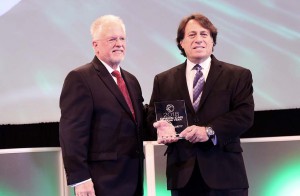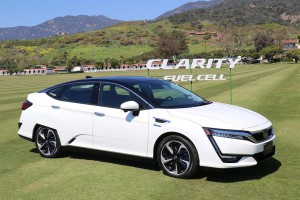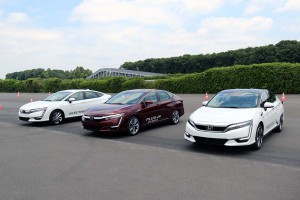
Ron Cogan, editor of Green Car Journal, presents Honda's Steven Center with the trophy for the Green Car of the Year: the Honda Clarity.
After years of slow growth, electric propulsion seems to finally be gaining traction, or so one might suspect based on the number of announcements being made just this week at the Los Angeles Auto Show.
More battery-based and hydrogen-powered vehicles than ever are on display at the L.A. Convention Center, with manufacturers promising to add hundreds more hybrids, plug-ins, battery-electric vehicles and fuel-cell vehicles over the next few years.
The L.A. Auto Show also saw the results of a shoot-out between the environmentally friendly vehicles already on the market, with the Honda Clarity being named Green Car of the Year. The decision was based, in part, the editor of Green Car Journal explained, on the fact that Honda is offering three different alternatives of the Clarity: a hydrogen-powered model, a plug-in hybrid and an all-electric version.
That approach is expected to become increasingly popular in the coming years. Hyundai is rolling out three versions of its Ioniq, sibling Korean carmaker Kia confirming two alternatives of its new Niro. And BMW said on Wednesday that it will engineer all future vehicles to be able to use a broad mix of alternatives, including gas, diesel and various electric drivelines.
(Honda a finalist in North American Car, Truck and Utility Vehicle of the Year. Click Here for more.)
“The entire industry’s strategy for green car has changed dramatically,” said editor Ron Cogan, during a ceremony at the L.A. Auto Show on Thursday morning. “A tipping point has been reached. Automakers are all-in.”
Plans for new, green models highlighted every news conference during a two-day auto show media preview, as well as events off-site earlier in the week. Volkswagen, for example, outlined plans similar to BMW’s. VW said it will launch a pure battery-electric SUV based on the I.D. Crozz concept it first showed off a year ago. The German maker plans to spend $40 billion to develop new battery cars and autonomous vehicles during the next five years alone.
Honda, for its part, was a pioneer in the early development of conventional hybrids, but has been slow – until now – moving into more advanced battery technology. The new Clarity “family” is part of a push by the automaker’s CEO to bring to market the vehicles he expects will generate about two-thirds of its sales by the end of the next decade.
Winning the Green Car of the Year award “validates Honda’s approach to electrification,” said Vice President Steve Center, as he claimed the crystal trophy.
(Click Here for more about the Green Car of the Year award finalists.)
The Clarity had gone up against a mix of finalists that underscored the breadth of green machines coming to market. They included the Hyundai Ioniq, the Toyota Camry hybrid, a hybrid version of Honda’s midsize Accord and the second-generation Nissan Leaf.
In 2010, the original Leaf became the world’s first volume battery-electric vehicle. The automaker is hoping to gain more traction with the 2018 remake by, among other things, boosting range to around 150 miles. (A longer-range alternative will be added next year.)
Driving up range and dropping the price of battery technology has been a critical development. The technology has its drawbacks and proponents admit that government incentives and manufacturer subsidies are still needed. But a recent study by the Boston Consulting Group projected that within about five years electrified vehicles will no longer require a financial helping hand. A kilowatt-hour of lithium-ion batteries that cost almost $1,000 in 2010 is expected to drop to $70 or less.
At first glance, the L.A. show might seem to be almost an anti-green event, with its heavy emphasis on SUVs and CUVs. But where those vehicles were once the stuff that environmentalists hated, the situation has shifted sharply. New designs – and efforts to improve aerodynamics and cut weight – means that the latest utes have relatively little mileage penalty compared to conventional sedans. And, going forward, manufacturers are planning to electrify all products, not just a handful of dedicated compacts.
(To see more about the Honda Clarity, Click Here.)
In the years to come, then, there will likely be a lot more candidates the jury will have to consider when deciding on the Green Car of the Year.


